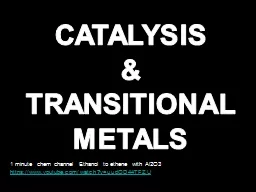

METALS 1 minute chem channel Ethanol to ethene with Al2O3 https wwwyoutubecomwatchvuudOD44TFZU Catalysts work by providing AN ALTERNATIVE REACTION PATHWAY WHICH HAS A LOWER ACTIVATION ENERGY ID: 781455
Download The PPT/PDF document "CATALYSIS & TRANSITIONAL" is the property of its rightful owner. Permission is granted to download and print the materials on this web site for personal, non-commercial use only, and to display it on your personal computer provided you do not modify the materials and that you retain all copyright notices contained in the materials. By downloading content from our website, you accept the terms of this agreement.
Slide1
CATALYSIS&TRANSITIONAL METALS
1 minute
chem
channel Ethanol to
ethene
with Al2O3
https
://
www.youtube.com/watch?v=uudOD44TFZU
Slide2Catalysts work by providing… “AN ALTERNATIVE REACTION PATHWAY WHICH HAS A LOWER ACTIVATION ENERGY”
CATALYSTS - lower E
a
A GREATER PROPORTION OF PARTICLES WILL HAVE ENERGIES
IN EXCESS OF THE MINIMUM REQUIRED SO MORE WILL REACT
WITHOUT A CATALYST
WITH A CATALYST
Slide3The area under the curve beyond Ea corresponds to the number of molecules with sufficient energy to overcome the energy barrier and react.
Lowering the Activation Energy,
E
a, results in a greater area under the curve
after Ea showing that more molecules have energies in excess of the Activation Energy
Ea
EXTRA NUMBER OF MOLECULES WITH SUFFICIENT ENERGY TO OVERCOME THE ENERGY BARRIER
MAXWELL-BOLTZMANN DISTRIBUTION
NUMBER OF MOLECUES WITH
A PARTICULAR ENERGY
MOLECULAR ENERGY
DUE TO THE MANY COLLISONS TAKING PLACE IN GASES, THERE IS A SPREAD OF MOLECULAR ENERGY AND VELOCITY
Slide4Catalysts are in a different phases, the surface of a solid and the gas which adsorbs onto the surface forming weak bonds with metal
atoms.
There are 3
stages...
Adsorption Dissimilar surfaces cling together. Incoming a gas landson an active site (a solid), often a transitional metal. Ex. (Pt)
Reaction Adsorbed gases are held in just the right orientation for a reaction to occur. This increases the chances of favourable collisions taking place (satisfying both tenants (parts) of the Collision Theory.
Desorption products are then
released from the metal
Heterogeneous Catalysis
3min
https
://
www.youtube.com/watch?v=R27PkAWqSTc
Slide5HETEROGENEOUS CATALYSTS
Example reaction – V
2
O
5
in Contact Process. Which is catalyst and which is reaction intermediate?
Step 1: V
2
O
5
+ SO
2
V
2
O
4
+
SO
3
Fast
Step 2 : V
2O4 + ½ O2 V2O5 Slow Overall: SO2 + ½ O2 SO3
Slide6Heterogeneous CatalysisANIMATION
Slide7HETEROGENEOUS CATALYSTS
1) Reactants a
d
sorbed onto surface (onto
active sites)
.
weakens bonds
brings molecules closer
more favourable orientation
2) Reaction takes place.
3) Products are desorbed (leave the surface).
Too strong (e.g. W)
Reactants cannot move round
surface and products
cannot desorb.
Too weak (e.g. Ag)
Reactants not adsorbed.
Ideal (e.g. Ni, Pt)
W
Slide8HETEROGENEOUS CATALYSTS
Nature of catalyst
Large surface area.
Spread thinly over ceramic honeycomb.
Catalytic Poisons :
Some
substances may block active sites (i.e. they adsorb and will not come off). Can ruin catalyst.
e.g.
Pb
in catalytic converters
Chem
Channel (1min)
https
://
www.youtube.com/watch?v=6XxgiiA1e9s
Slide9Homogeneous CatalysisCatalyst and reactants are in the same phase and transition with metal ions
Example
:
Acids Catalyst in Esterificaton
where all are (aq) CH3COOH + C2
H5OH CH3COOC2
H5 + H2O
No H
+
catalyst
SLOW step
With H
+
catalyst
FASTER.
Note it can be done with
H
2
O
but much slower
H
2
O
1(min)
https
://
www.youtube.com/watch?v=1MoTHw1Rfxk
Slide10T
ransition
metal catalyst
works
by metal varying oxidation
state
Mn
2
+
e.g. 2 MnO
4
-
+ 16 H
+
+ 5 C
2
O
4
2-
→
2 Mn
2+
+ 8 H
2
O + 10 CO
2
the reaction is catalysed by one of the products (Mn2+) so is
autocatalysis
HOMOGENEOUS CATALYSTS